|
 Holed Stones:
(Stones with holes in them)
Holed Stones:
(Stones with holes in them)
Cutting holes in stones was a
recurring theme in the ancient world. It is likely that many holed-stones had
ritualistic or symbolic functions.
There are a number of Holed stones in the
Maltese temples such as
Hagar Qim,
Mnajdra, and the Hypogeum
Stone-cut doorways
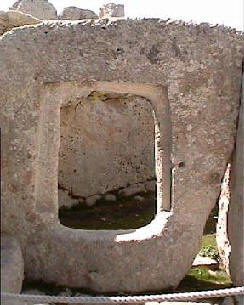
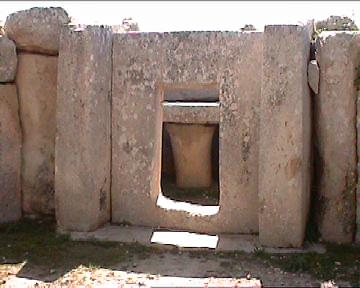
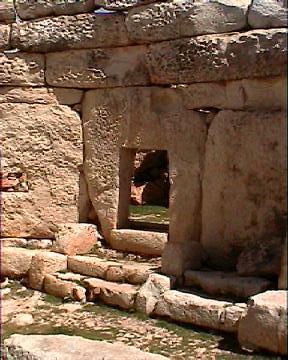
The stone in the photo (above-left) can be seen to have had a
'frame' carved around it, It is not clear whether these were functional or
just decorative. The same design feature can be seen between chambers in the
underground
Hypogeums.
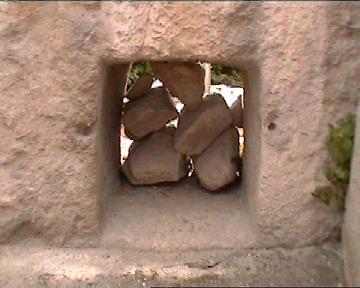
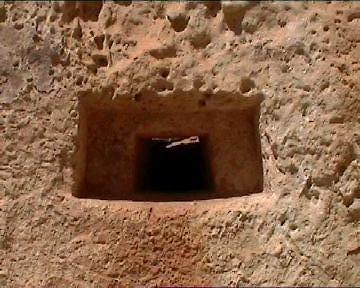
The Maltese temples also have several smaller carved holes, which are suggested
as having originally served as 'oracle' holes. Although there is no particular
evidence to support this theory it is tempting ( because of their setting
in the temples), to attach a ritualistic
function to them.
(Click
here for more about Malta)
The
Great pyramid
of Ghiza contains examples of holed-stones in it. In particular, are the
three stones that encircle the ascending passage called the 'Girdle-stones'.
Their placement means that anyone wishing to enter the upper parts of the
pyramid has to pass through them.
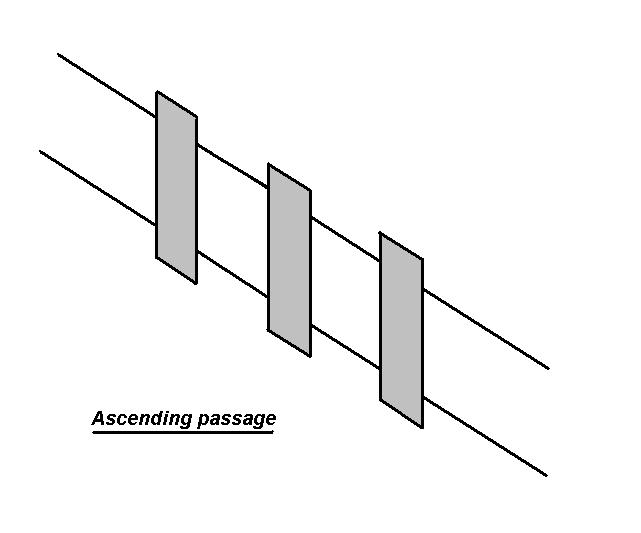
These three giant holed-stones are composed of granite (in distinction to the
rest of the passage). It has been suggested that they are a part of a
previous exterior casing, although their composition, size and the angle
of slope between them (26 �)
makes this
unlikely. Their particular relevance has yet to be identified, but as they
offer no particular structural benefit (over that already employed in the
design of passages), and they are not found in any other pyramid, it can
be assumed that they had a ritualistic function.
There are also two Holed-stones in the walls of the 'Queens-chamber'.
Although the blocks they were cut into are themselves several feet in
length, the holes are only a few inches wide. They were left unfinished and
only discovered in 1872 by
Waynman Dixon and D. R. Grant.
The Queens Chamber 'star-shafts' were originally left sealed
with 5 inches of uncut masonry on their inside ends, the blocks they start
from having been skilfully hollowed out for several feet behind. The following
is Piazzi Smyth's record of the Dixon brothers' own testimony:
'Dr. Grant and Mr. Dixon have successfully proved that there
was no jointing, and that the thin plate was a 'left', and a very skilfully
and symmetrically left, part of the grand block composing that portion of the
wall on either side'
(10)
The star-shafts run up to the 50th course of
the Great pyramid (the same level as the Kings-chamber above). They were
apparently never intended to enter or exit the pyramid as they were sealed
at both ends.
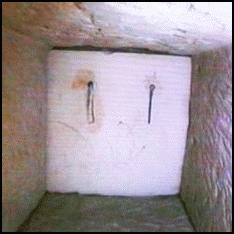
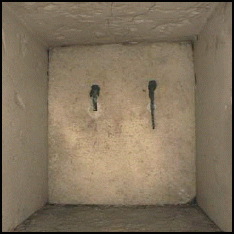
In
1993, Rudolph Gantenbrink sent a remote viewer up the so
called
star-shafts only to find
each one ending with a symbolic 'door'
(with handles on the
the inside).
In 2002, another robot was sent to the end of the southern
shaft to investigate further. A 3/4-inch hole was drilled in the slab and,
on 17 September, a miniature fibre-optic camera was inserted to reveal a
rough-hewn blocking stone lying 7 inches beyond the original southern shaft
slab.
All access
to the shafts has since been refused.
(More about the Star-shafts)
England has several examples of 'Holed
stones'. It is believed that many are remnants of dolmens,
or Neolithic burial chambers, of which the
holed-stones were once the
entrances. Whatever their original purpose was, the
ideas and customs associated with them are remarkably similar from the
Orkneys to the far west of Cornwall.
Men-an-Tol -
Cornwall, England - (Also called
'The
Devil's eye')
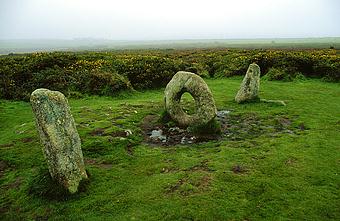
The stones at this site are no
longer in their original setting, which
archaeologists have now determined to have once been a triangle. Traditional rituals at
M�n-an-Tol, involved passing naked children three times through the
holed stone and then drawing them along the grass three times in an
easterly direction. This was thought to cure scrofula (a form of
tuberculosis) and rickets. Adults seeking relief from rheumatism, spine
troubles or ague were advised to crawl through the hole nine times against
the sun. The holed stone also had prophetic qualities and, according to
nineteenth-century folklorist Robert Hunt: If two brass pins are
carefully laid across each other on the top edge of the stone, any
question put to the rock will be answered by the pins acquiring, through
some unknown agency, a peculiar motion.
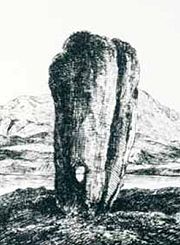
The 'Odin Stone' near the Stennes Circle, Orkneys, Scotland.
Now sadly destroyed, any promises made with clasped hands through the hole
in this stone were said to be unbreakable. The stone was also used by local
lovers to 'plight their troth'. It was destroyed in 1814 by the local
farmer, following which locals tried to set fire to his house twice.
(More about the Orkney complex)
It is suggested by Wier
(1), that some Irish megaliths had
their holes at groin level, and had a diameter suitable for the 'ritual
insertion of a living penis'. The following examples are given:
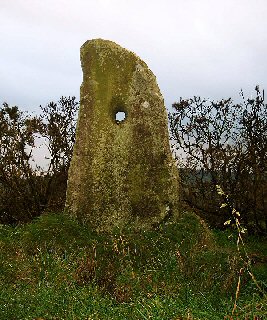
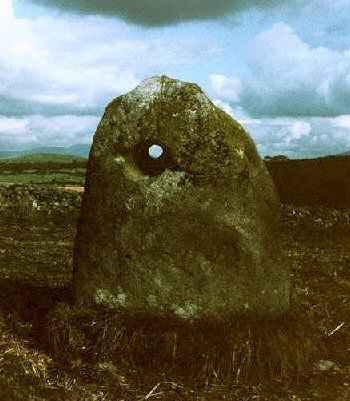
The 'Hole Stone',
Doagh, Co. Antrim, Ireland (left), and the 'Craw Stone', Craws, Ireland
(right).
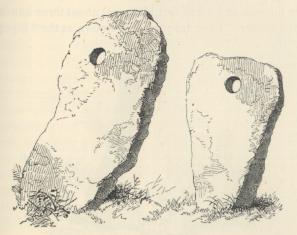

Bolleit (left) and Tregesal (right)
|
Other Examples of Holed Stones: |
W �ris, Belgium:
The
two main dolmens in the W�ris
complex in Belgium both have holed entrances or 'spirit holes'. they are
a common feature in Northern European Dolmens.
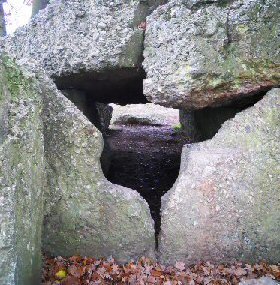
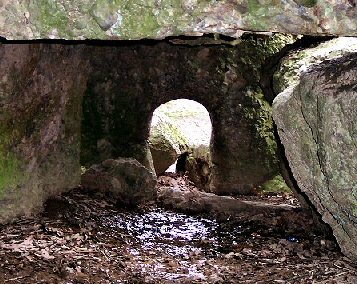
Northern Dolmen (left), and Southern Dolmen (right). Built in different
styles.
(More about the W �ris
complex, Belgium)
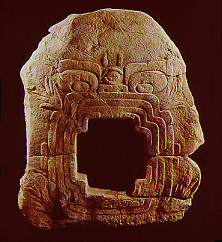
The
Jaguar Stone - (Photo, Left. 72 in,
1.8m high).
This Olmec stone was found at the entrance to a natural cave. It is
dated from 800 to 100 BC, and is from Chalcatzingo, Morelos,
Mexico.
(More about the Olmecs)
Also from the Mexican Peninsula, Van Sertima
(5), mentions that one of the
large granite stone heads from La Venta had a hole in it:
'The largest of the four - nine feet high - had its domed
top flattened so that it could function as an altar. A speaking tube was
found going in at the ear and out at the mouth; it was used as an
oracle, a talking god. It was also, according to
Stirling, associated with the first construction phase of the ceremonial
court.'
(More about the 'African' heads)
The Caucasus Dolmens, Russia.
This area
is littered with dolmens with 'spirit holes'
in them (over 3,000 reported). The holes have a similar design as that seen in megalithic
constructions in Sardinia, Sicily ('Tombas
di Giganti'),
and the U.K. It is not yet determined whether the holes facilitate an
astronomical function, similar to the 'light-boxes' seen at
Newgrange
and Carrowkeel
in Ireland, or whether they served another function or
sacred
purpose.
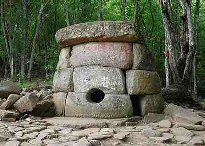
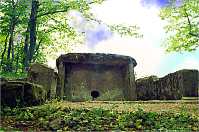
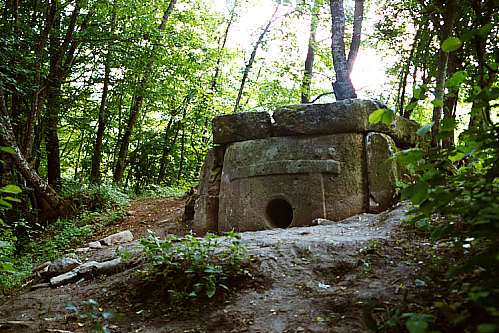
A selection of the numerous designs of 'Caucasus Dolmens'.
(More about the Caucasus
Dolmens)
Spanish Holed Stones:
The Cueva de Viera passage mound at Antequera has two holed stones in it,
one half way along the passage and one at the end separating the passage
from the small chamber at the heart of the mound, which is orientated
towards the autumn equinox.
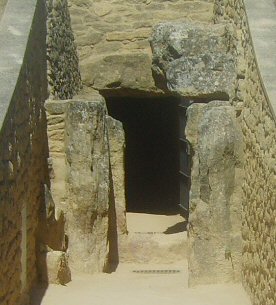
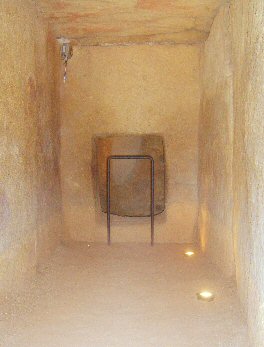
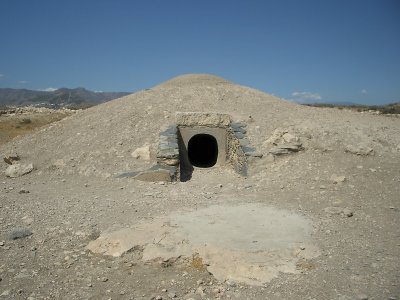
In addition, the Neolithic Fortified
Settlement at Los Millares has over eighty Tholos mounds,
many of which have holed stones for their entrances
(More about the Cueva de Viera and the Menga
complex)
(More about Los Millares) |